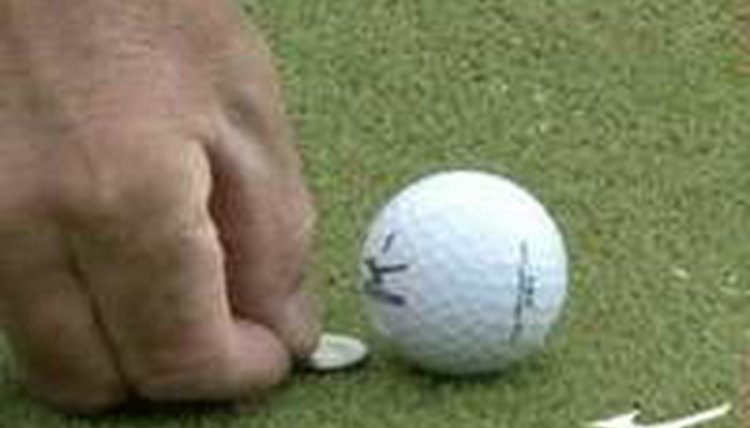Golf Ball Marker Rules

It is necessary in golf to mark your ball once it is on the green in order to allow players further away to putt. If players did not mark their golf balls, then other players might hit the ball with their ball when they putt. Marking a golf ball on a green must be done properly and according to the rules of the game, or players can be subject to penalties.
Overview
It is necessary in golf to mark your ball once it is on the green in order to allow players further away to putt. If players did not mark their golf balls, then other players might hit the ball with their ball when they putt. Marking a golf ball on a green must be done properly and according to the rules of the game, or players can be subject to penalties.
Marking Rules and Etiquette
A player may mark her ball by placing a ball marker or a small coin, such as a dime, right behind where the ball lies on the green. The key phrase here is “right behind,” as it is not recommended to place the marker anywhere else, such as in front or to the side, to designate where the ball was, even though this is legal. Marking in front of the ball may alter the green in some way and is discouraged.
Moving a Marker
Since the ball marker is considered a movable obstruction by the rules of golf, it can be moved by a player without incurring a penalty.
If a player requests that a ball marker that seems to be in the line of his putt be moved, it can be.
When a player chooses to putt her golf ball with the ball marker in place and hits the marker, the deflected golf ball must be played from where it ends up on the putting surface.
A player may mark his own ball or have anyone that is authorized to do so, such as his caddy, mark the ball on the green. If the ball being marked is accidentally moved, no penalty is assessed. To move a marker, it should be placed one or more full club lengths to one side.
Penalty Scenarios
There are golf rules that cover a host of ball-marking scenarios.
If a player drops her marker on the golf ball and moves it, the penalty is one stroke. However, there is no penalty if a marker is accidentally knocked away by such forces as the wind, an opponent or even an animal. If a player believes that a hole has been won and picks up his marker before the hole has been decided, a one-stroke penalty results. The player that marks her ball and then fumbles it as she tries to pick it up suffers no penalty.
But the player that even by accident kicks his ball when making a movement to lift it is penalized, since under the rules this was not caused by an attempt to lift the ball.
It is a one-stroke penalty to mark a ball by placing the marker more than an inch behind the ball.
If a player fails to employ a marker and instead decides to use a certain blemish or distinguishable spot on the green as a reference point, then a one-stroke penalty is the result of such action. Players may elect to use the toe of one of their own golf clubs or other objects as a marker without penalty.
Writer Bio
John Lindell has written articles for "The Greyhound Review" and various other online publications. A Connecticut native, his work specializes in sports, fishing and nature. Lindell worked in greyhound racing for 25 years.
